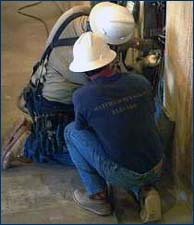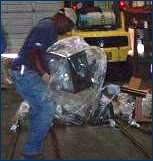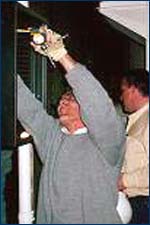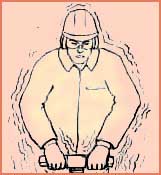Solutions for Electrical Contractors eTool
Supplemental Information » Hazard Index

Electricians may be exposed to the hazards listed below. These are common ergonomic hazards that occur in the construction trades.
Awkward postures means working with various parts of the body in bent, extended or flexed positions rather than in a straight or neutral position. Working in awkward postures increases the exertion and muscle force that employees must apply to complete a task and compresses tendons, nerves and blood vessels. In general, the more extreme the posture the more force is needed to complete the task.
Examples of awkward postures include any task that may:
- pull the elbows away from the torso such as performing overhead work or reaching in front, to the side, or in behind the body;
- bending the elbow past about 90 degrees for prolonged periods of time;
- bending or twisting the torso to lift an object from low or distant locations;
- extending, flexing, or bending a wrist to the side while using tools or performing connection tasks;
- bending the neck backward or forward for prolonged periods while working overhead or on low surfaces; and
- bending the knee or ankle to work in a squatting or kneeling position.

Repetitive elbow bending can irritate nerves and tendons in the forearms, and even lead to epicondylitis, or "tennis elbow".

Working with wrists in a bent rather than straight position increases the risk of injury especially where the task also involves high hand force. Working with bent wrists puts stress on the tendons and tendon sheaths in the hands and wrists. When the wrists are bent the tendons and sheaths rub against hard bones and ligaments. If this happens repeatedly, the tendons and sheaths can become irritated and inflamed, resulting in injuries such as tendonitis. The inflamed tendons and sheaths can also press against the nerves that run through the wrist to the hand, resulting in carpal tunnel syndrome.
General controls to reduce awkward wrist postures:
- Tool handles may be bent or modified depending on the task to allow the user to maintain a straight, neutral wrist.

Contact stress results from prolonged or repeated contact between hard or sharp objects/surfaces and sensitive body tissue, such as soft tissues of the fingers, palms, thighs and feet. This contact creates localized pressure for a small area of the body, which can inhibit blood flow, nerve function, movement of tendons and muscles and create localized irritation.
Some contact stress problems include:
- Use of tools with short handles which can press into the palm of the hand.
- Standing for long periods of time on hard and small areas such as ladder rungs which may create pressure on the arch of the foot.
- Carrying hard or sharp items such as ladders or conduit on the shoulder where muscles and tendons can be irritated.
General controls to reduce contact stress:
- Use electric or power tools to minimize repeated hand activations.
- Purchasing tools with appropriately-designed handles (should have a span of about 2 inches, a diameter of about 1.5 inches, should be long enough to extend across the palm, and may be bent to minimize wrist bending).
- Wrap or coat tool handles and grips with cushioning material.
- Use gloves with palm pads.
Use shoes with thick or cushioned soles to spread the force over a wider area.

Electrical employees will frequently need to bend or crouch to reach the work space. This kind of activity can contribute to poor circulation of blood, and may injure the knees where they come in contact with the floor.

Many tasks require employees to lift, push, pull and carry heavy loads. Heavy lifting can result in overexertion and injury to the lower back.
How much weight an employee can safely lift depends on a number of factors. When the factors are such that the employee can assume an "ideal" body posture during the lift, the employee is able to lift greater loads. However, when the body posture is not ideal (e.g., back is bent or arms are outstretched), then the amount of weight the employee can safely lift is reduced. Factors affecting how much weight an employee can safely lift include:
| Lifting factors | More weight can be safely lifted when: | The amount of weight that can safely be lifted is reduced when: |
|---|---|---|
| How far from the body the load is held (horizontal distance). | The load is close to the body and not too large/bulky, which allows the arms and elbows to be close to the torso during the lift. | The load is farther away from the body or is large/bulky, forcing the arms and elbows away from the torso during the lift. |
| How high or low is the lift (vertical distance). | The lift is at waist height. | The lift must be made from below the knees or above the shoulder. |
| How much the employee must twist to lift and move the load. | The lift is performed in front of the body. | The employee must twist the torso to lift and move the load. |
| How often the lift is repeated. | The lift is performed only occasionally. | The lift is performed repeatedly (several times a minute). |
| How far the load is carried. | The lift does not involve carrying. | The load must be carried a distance (more than 3 feet). |
| How the load is gripped. | The load has handles. | The load does not have handles or is slippery. |
General controls to reduce lifting hazards:
- Use lift assists such as hand trucks, carts, and forklifts.
- Reduce size of product boxes to lighten load.
- Arrange work space so employees can move closer to loads and perform lifts with arms close to the body.
- Use pallets that can rotate.
- Put objects to be lifted at waist level.
- Arrange workstation so lifting is done in front, without twisting.
- Put handles or grips on boxes.
- Use gloves that aid in holding slippery objects.

A number of tasks require employees to work with their hands above their head or shoulders, their arms extended to arm's length, or their elbows raised out from their body. These kinds of tasks place stress on the shoulders, elbows and back, and can result in an ergonomic injury.
Elevated reaches - Examples of jobs and tasks that require employees to repeatedly reach or work with their hands above their head or their elbows above their shoulders include:
- Installing ceiling fixtures
- Pulling wire in a plenum space
Extended reaches - Employees also have to perform extended reaches when there is not adequate access to the work area, extending the elbows away from the body. Examples include:
- Lifting a bulky, large load
- Providing improper hand tools may force employees to raise their elbows away from the torso in order to prevent wrist deviation.
- Using in-line tools on horizontal surfaces can force shorter employees to lift their elbows as high as shoulder height in order to keep their wrists straight.
General controls to reduce reaching hazards:
- Ladders and lifts to reduce reaching.
- Bent handled tools that allow straight wrists and elbows close to the body.
Some tasks involve repeating the same actions with little variation. When motions are repeated frequently for prolonged periods, such as several hours without any break or over an entire work shift, there may be inadequate time for muscles and tendons to recover. If the repetitive tasks also involve other ergonomic risk factors, muscles and tendons become extremely strained or fatigued more quickly.
Highly repetitive tasks often involve the use of only a few muscles or body parts while the rest of the body is unaffected. To reduce the strain that repetitive tasks pose to those body parts, use these solutions:
- Rotate employees into several different jobs during the course of a work shift is a way to distribute work so that each employee spends less time performing the same repetitive tasks. In order for job rotation to reduce muscle/tendon strain and provide adequate recovery time, the different jobs into which employees rotate need to involve the use of different muscles or body parts.
- Design jobs so they include a wider variety of tasks (longer motion pattern) is another way to reduce the frequency and duration of repetitive motions.
- Build short micro pauses between motions or tasks is another way to give muscles and tendons recovery time.
Maintaining the same posture for an extended period of time can cause problems including pooling of blood and fatigue in muscles. Long periods of standing can cause pain and contact stress to the feet.
Extreme temperatures can cause problems for employees. Cold temperatures make the muscles less flexible, resulting in muscle strain and pulls. Hot temperatures lead to dehydration and muscle fatigue.

The back is designed to operate efficiently with both hands lifting loads directly in front of the body. In this manner muscles work symmetrically in tandem across a balanced spine.
Twisting the torso creates an asymmetry which stretches some sets of muscles while compressing others forcing smaller, isolated groups of muscles to provide the needed force for the task. Twisting the spine creates non-symmetrical forces on the fibers of the disc which weakens the structure making it more susceptible to bulging and rupture from the compressive force created during lifting.
Supporting a load with the torso bent forward greatly increases both the muscle force which must be exerted and the compressive force on the spine. When significant force exertion is combined with the structural instability created from twisting, the opportunity for injury is greatly increased.

Although using powered hand tools may help reduce employee exposure to ergonomic risk factors such as repetition and force, they can expose employees to vibration. Vibration restricts the blood supply to the hands and fingers, which, depending on the vibration level and duration of exposure, can contribute to an ergonomic injury. Signs and symptoms of vibration-induced injury, such as Reynaud's phenomenon, start with occasional numbness or loss of color in the fingertips. They progress to more frequent and persistent symptoms affecting a larger area of the fingers and resulting in reduction in feeling and manual dexterity.
Factors that increase the amount of employee exposure to vibration include:
- Bad power tool design - Even new tools can expose employees to excessive vibration if they are not designed with devices that dampen or shield employees from vibration.
- Poor power tool maintenance.
- Old power tools.
General controls to reduce vibration:
- Use low vibration tools.
- Use vibration dampeners or shields to isolate source of vibration from employee.
- Inspect and maintain power tools regularly.
- Limit the duration of tasks that involve vibration, and rotate tasks.

